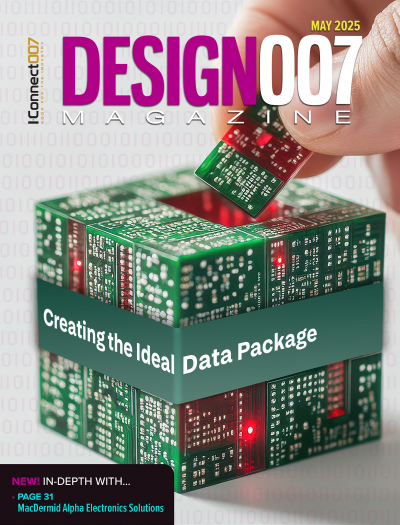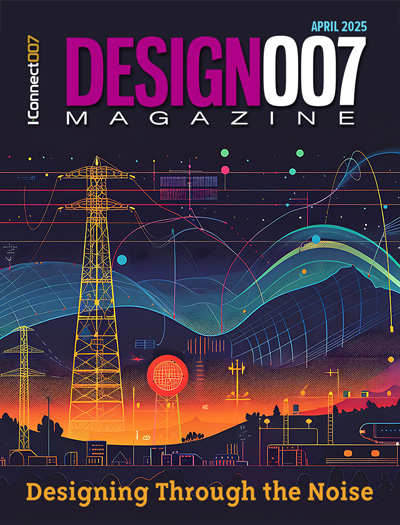-

- News
- Books
Featured Books
- design007 Magazine
Latest Issues
Current Issue
All About That Route
Most designers favor manual routing, but today's interactive autorouters may be changing designers' minds by allowing users more direct control. In this issue, our expert contributors discuss a variety of manual and autorouting strategies.

Creating the Ideal Data Package
Why is it so difficult to create the ideal data package? Many of these simple errors can be alleviated by paying attention to detail—and knowing what issues to look out for. So, this month, our experts weigh in on the best practices for creating the ideal design data package for your design.

Designing Through the Noise
Our experts discuss the constantly evolving world of RF design, including the many tradeoffs, material considerations, and design tips and techniques that designers and design engineers need to know to succeed in this high-frequency realm.
- Articles
- Columns
- Links
- Media kit
||| MENU - design007 Magazine
Jan Pedersen: CircuitData Enhances Current Data Formats
April 11, 2018 | I-Connect007 Editorial TeamEstimated reading time: 8 minutes
During the Design Forum at IPC APEX EXPO 2018, Jan Pedersen, senior technical advisor for the PCB broker Elmatica, gave a presentation on CircuitData. The language is designed to help facilitate other design data transfer formats such as Gerber, ODB++, and IPC-2581. Jan spoke with Managing Editor Andy Shaughnessy and Contributing Technical Editor Happy Holden about how this open language works with the existing data formats, as well as the need to eliminate paper documents from design process, and how the industry can help shape this open-source language.
Andy Shaughnessy: Jan, I enjoyed your presentation. During your talk, you discussed the CircuitData tool. Tell us a little bit about that and how it works.
Jan Pedersen: Yes. CircuitData is a language. It's a digital language to communicate an article specification. And the corporate profiles, like EMS profiles, have requirements that are added normally to PCB specification as a PDF file or as a paper. We want to make these digital. We want to make it easy and we want to make it open-sourced so that it's not a limitation, or competition for any company. There should not be any competition between different companies. CircuitData is primarily a language to communicate the article specification.
Happy Holden: Can you step back and define the difference between a language and a PDF data file? Right now, information is in a PDF data file, so what is the difference if those words are in this language?
Pedersen: The language is a digital language that the computer can read. A computer cannot read a PDF.
Holden: What do you mean by "read"?
Pedersen: You can read it through your own ERP system. You probably have a template yourself where you have the article specification in your ERP. You can read this file directly or you can export it from your own ERP system. It's not a new a software. It’s just a language, and a way to communicate an article specification digitally.
Holden: Is this a language that allows it to be a schema for a database?
Pedersen: It is a schema. It's very similar to IPC-2581.
Holden: Is it a database that you can then search on? Whereas with a PDF you can't do a search and it doesn't know what that field means that has a particular word in it?
Pedersen: Exactly.
Shaughnessy: You say it works with ODB++, Gerber, and IPC-2581. What are some of the challenges of working with those formats that your language helps overcome?
Pedersen: How it is today is that we receive simple Gerber files, external Gerber files, all of these things, but it doesn't say anything about the stack-up, the material, the color of the solder mask or the final finish? It says nothing.
What we're trying to do is to make this article specification that comes as read-me file, a PDF or Excel or whatever it is, so you get an export file besides the Gerber. Today, IPC-2581 does that, but that's very comprehensive. We want to make it simple, open-sourced and free of charge.
Shaughnessy: It sounds like you're automating it more, and making it more user-friendly.
Pedersen: Yes, absolutely. But what we do today is this: We receive all of these papers, or documents that are like paper. And we need to translate them. We type it into our system, and when it comes to the board shop, they retype it. They type it into their system so they can create their own job cards so they can do feasibility studies. They need to know "What do we have here? How do we describe this board that we are receiving? Is it an RFQ or an order?"
Now, this is the description of the board, the article specification that starts with the designer. Then it comes to the EMS company, they have some other requirements so they can update the file. And then they have one file that they send to a broker like us, or directly to the PCB shop. So, for the PCB shop, the ultimate thing is to receive one file that they can read into their own computer, in their own language.
Page 1 of 2
Suggested Items
Driving Innovation: Direct Imaging vs. Conventional Exposure
07/01/2025 | Simon Khesin -- Column: Driving InnovationMy first camera used Kodak film. I even experimented with developing photos in the bathroom, though I usually dropped the film off at a Kodak center and received the prints two weeks later, only to discover that some images were out of focus or poorly framed. Today, every smartphone contains a high-quality camera capable of producing stunning images instantly.
Hands-On Demos Now Available for Apollo Seiko’s EF and AF Selective Soldering Lines
06/30/2025 | Apollo SeikoApollo Seiko, a leading innovator in soldering technology, is excited to spotlight its expanded lineup of EF and AF Series Selective Soldering Systems, now available for live demonstrations in its newly dedicated demo room.
Indium Corporation Expert to Present on Automotive and Industrial Solder Bonding Solutions at Global Electronics Association Workshop
06/26/2025 | IndiumIndium Corporation Principal Engineer, Advanced Materials, Andy Mackie, Ph.D., MSc, will deliver a technical presentation on innovative solder bonding solutions for automotive and industrial applications at the Global Electronics A
Fresh PCB Concepts: Assembly Challenges with Micro Components and Standard Solder Mask Practices
06/26/2025 | Team NCAB -- Column: Fresh PCB ConceptsMicro components have redefined what is possible in PCB design. With package sizes like 01005 and 0201 becoming more common in high-density layouts, designers are now expected to pack more performance into smaller spaces than ever before. While these advancements support miniaturization and functionality, they introduce new assembly challenges, particularly with traditional solder mask and legend application processes.
Knocking Down the Bone Pile: Tin Whisker Mitigation in Aerospace Applications, Part 3
06/25/2025 | Nash Bell -- Column: Knocking Down the Bone PileTin whiskers are slender, hair-like metallic growths that can develop on the surface of tin-plated electronic components. Typically measuring a few micrometers in diameter and growing several millimeters in length, they form through an electrochemical process influenced by environmental factors such as temperature variations, mechanical or compressive stress, and the aging of solder alloys.


